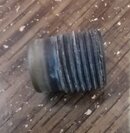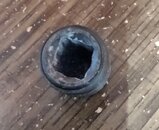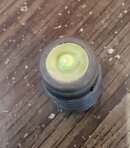This is the seat of an MDE (Midland Diving Equipment) valve.
I'm not entirely sure of the interconnections, but I believe the parts are now manufactured by the Cavagna Group or MDE got to be part of the Cavagna Group. Take this with a grain of salt!
That being said, MDE does not sell the seat (L100002) separately. They do sell the kit (HSDK), which contains all O-Rings, the seat, the stem and packing nut.
I have seen local divers in Africa remove the soft part of the seat and fill it with a molten polymer. I can't recommend doing so, for the following reasons:
- MDE changed the seat. What you have is still the old style, where that middle bit poking out of the "plastic" surface is also made of "plastic". This pin could under heavy use get really long and break off. That broken off piece could then lodge itself somewhere in air path. Hence MDE changed the style to a design with the middle rod machined directly from the blank. The "plastic" was then poured around the rod.
- A flat seat with a molten polymer could work itself lose from the seat carrier. This would result in an obstructed air path, cutting the air off in an instant.
I have seen both of the above happen. The locals I have seen do this did it only out of necessity.







